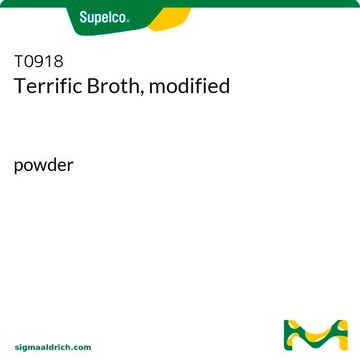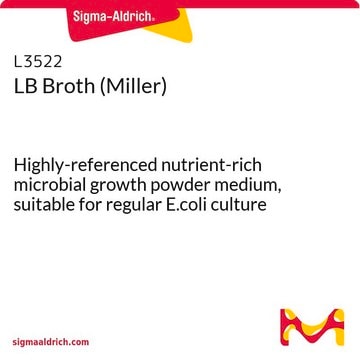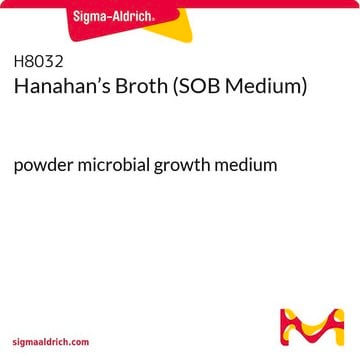T9179
Terrific Broth
EZMix powder microbial growth medium
Sinónimos:
TB media
About This Item
Productos recomendados
grade
for molecular biology
Quality Level
description
TB; quick dissolve, dust-free formulation
sterility
non-sterile
form
powder
technique(s)
microbiological culture: suitable
application(s)
agriculture
food and beverages
microbiology
storage temp.
room temp
suitability
nonselective for Escherichia coli
nonselective for coliforms
Categorías relacionadas
General description
Application
Terrific broth has been used:
- as a medium for selective growth of E.coli BL21 (DE3) V2RpRARE expressing MLL SET (nuclear proto-oncogene) domain in pET28GST-LIC
- to grow BL21 (DE3) cells containing plasmid expressing IL-8 (interleukin-8)
- Terrific broth is also suitable for use in bacterial suspension (Bacillus subtilis strain 1085B)
Features and Benefits
- Granulated, dust-free format for safer handling and faster mixing
- A budget-friendly alternative to liquid
- Modified formulation (without glycerol)
- Easy scale-up using larger package sizes
Components
23.6g/L Yeast Extract
11.8g/L Tryptone
9.4g/L K2HPO4
2.2g/L KH2PO4
Reconstitution
Legal Information
Related product
Storage Class
11 - Combustible Solids
wgk_germany
WGK 3
flash_point_f
Not applicable
flash_point_c
Not applicable
Certificados de análisis (COA)
Busque Certificados de análisis (COA) introduciendo el número de lote del producto. Los números de lote se encuentran en la etiqueta del producto después de las palabras «Lot» o «Batch»
¿Ya tiene este producto?
Encuentre la documentación para los productos que ha comprado recientemente en la Biblioteca de documentos.
Los clientes también vieron
Protocolos
General protocols for growth of competent cells in microbial medium.
Nuestro equipo de científicos tiene experiencia en todas las áreas de investigación: Ciencias de la vida, Ciencia de los materiales, Síntesis química, Cromatografía, Analítica y muchas otras.
Póngase en contacto con el Servicio técnico












